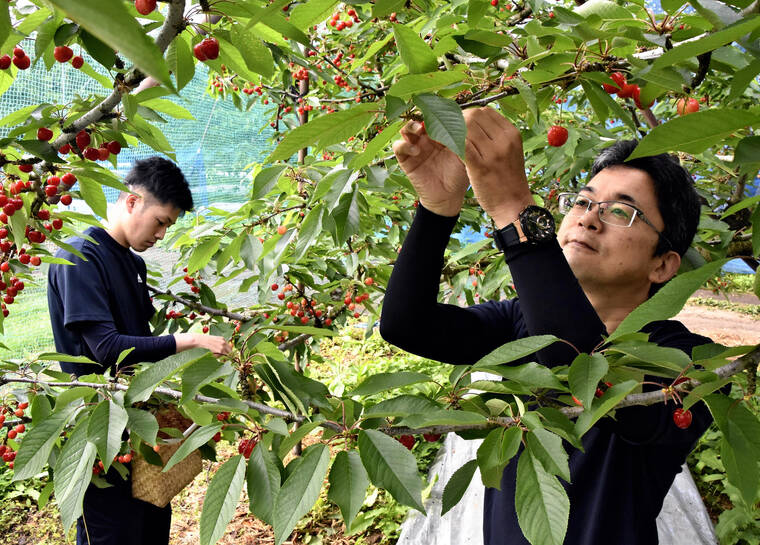Labor shortages changing policies on second jobs for public employees

JAPAN NEWS-YOMIURI
Tadashi Fukase, right, and Sota Kohei harvest cherries on June 10 in Higashine, Yamagata Prefecture.
YAMAGATA, Japan >> Local governments in Yamagata prefecture, Japan’s largest producer of cherries, are increasingly permitting civil servants to take on side jobs harvesting cherries as a means to deal with labor shortages amid a decline in farmers and an aging population. Currently, the prefecture and six cities have incorporated a system that makes space for second jobs for public employees.
The move is also expected to help deepen employees’ understanding of agriculture, which is a key industry in the region.
The new system is unusual in a country where employers often don’t permit their employees to work outside of their full-time job. There has been concern that the additional work could lead to poor performance or leaks of confidential company information.
But in April, the city of Higashine began permitting its employees to have side jobs, easing labor shortages for cherry farms. The city is the largest producer of cherries in the prefecture.
“Harvesting cherries needs to be done intensively, within about a month and a half. Some cherries are left unharvested due to labor shortages,” according to the city’s agriculture and forestry department.
On a Saturday in June, Tadashi Fukase, 48, and Sota Kohei, 20, busily picked bright red Sato Nishiki cherries in Higashine. The two are employees of the city’s Living Environment Department. They worked 5-7 a.m. for about $8 an hour in an orchard owned by Atsuyoshi Yoshida, 51, that had roughly 100 cherry trees.
Don't miss out on what's happening!
Stay in touch with breaking news, as it happens, conveniently in your email inbox. It's FREE!
During the harvest season, Yoshida is forced to compete with neighboring farmers for labor. “We put out help-wanted ads but can’t get enough workers. Even one more picker would be very helpful for me,” he said.
“Labor shortages have been an issue for a long time, but I didn’t know how I could help,” said Fukase. “I felt a sense of satisfaction doing this job, since I get paid.”
His workmate also walked away feeling positive. “Cherries are a local specialty, so it feels like I’m contributing to the local community,” said Kohei. “I want to continue working through this system.”
Last year, the prefectural and Sagae city governments implemented the same system.
In 2022 in Sagae, 23 employees, or about 6% of the workers eligible for side jobs, took advantage of the opportunity.
Five cities, including Higashine, began implementing their own systems this year.
The city of Nanyo allows side jobs related to any fruit crop. Kaminoyama allows nonagricultural side jobs if it serves the public interest.
The prefecture and all the cities set time limits for these positions so normal work hours for the employees are unaffected.
In 2020, local government staff conducted a multiple-choice survey of 156 government workers in the prefecture. When asked about the benefits of side jobs, the most common answer, selected by 71 people, was “expanding personal connections.” The second most common answer (67 respondents) was “contributing to the local community.” The results indicate that public employees feel positive about their side work.
The law on local civil service in principle bans public employees from running a company or earning income without permission. However, it permits activities that can contribute to community revitalization, such as helping with traditional community-based ceremonies, festivals and events.
Among local governments nationwide, in 2017, the city of Kobe pioneered lifting the ban on side jobs. The city set criteria for the work and allowed employment for such work as sign language interpretation and coaching club activities at junior high schools.
Many local governments followed suit and allowed farming jobs: Arida in Wakayama prefecture for oranges in 2020; Hirosaki, Aomori prefecture, for apples in 2021; and Fukushima for peaches and pears in 2022.
According to the Agriculture, Forestry and Fisheries Ministry, the number of people engaged in farming for their primary work nationwide declined from 2.05 million in 2010 to 1.36 million by 2020, exacerbating labor shortages.



